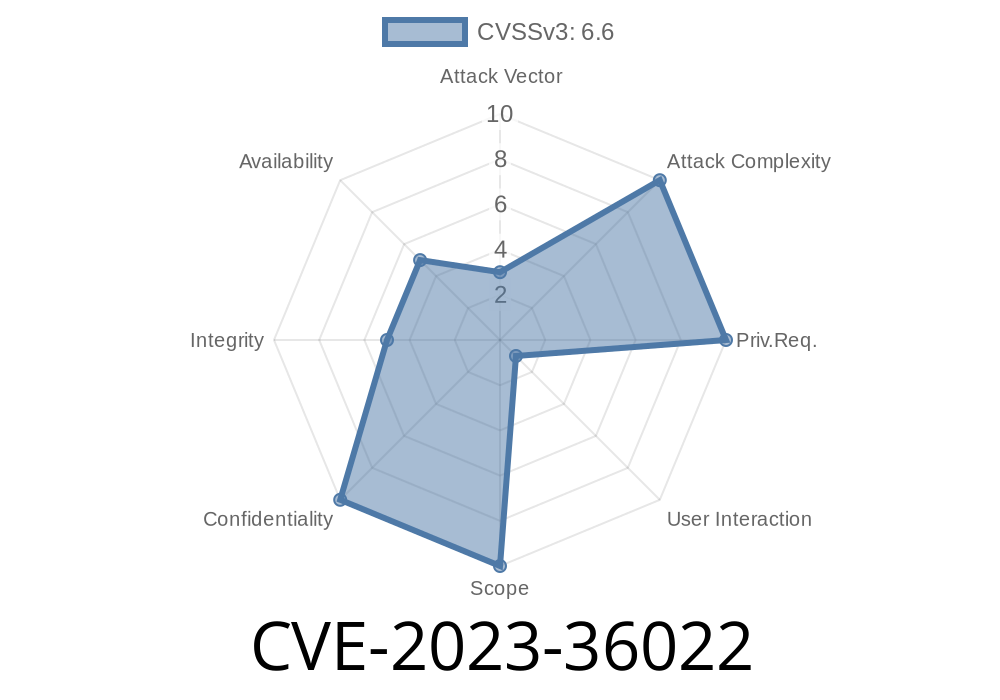Microsoft Edge, the popular Chromium-based web browser, is no stranger to security vulnerabilities. In this long-read post, we will take an in-depth look at the details of a critical vulnerability denoted by CVE-2023-36022, which allows for remote code execution (RCE) in Edge. We will explore the underlying exploit techniques, examine a sample code snippet, and discuss links to original references. By the end, you should come away with a greater understanding of this critical threat and the steps Microsoft has taken to address it.
Exploit Details
This specific vulnerability, CVE-2023-36022, is a remote code execution vulnerability in Microsoft Edge (Chromium-based). It exists due to a type confusion error in the JavaScript engine, which, if exploited, can lead to arbitrary code execution on a targeted system. Without proper patching and security measures in place, an attacker can potentially compromise the targeted system by simply convincing the user to visit a malicious webpage designed to exploit this vulnerability.
Code Snippet
To better understand the exploit, let's examine a sample exploit code snippet. Note that this code is purely for educational purposes and should not be used for malicious activities. The following JavaScript code snippet demonstrates a proof-of-concept attack:
function triggerTypeConfusion() {
let arr = [1.1];
let object = {a : 1};
let index = Array.prototype.indexOf.call(arr, object);
arr[index] = 1.745; // Type confusion occurs here.
}
(function runExploit() {
try {
triggerTypeConfusion();
} catch(e) {
console.error(e);
console.log("Exploit failed");
}
})();
In this code, we are simulating a type confusion scenario by calling the native Array.prototype.indexOf method, which expects a numeric value. Instead, we pass an object to the method, triggering a type confusion error.
As a result, when we change the value of the array index to a different numeric value, a type confusion occurs, which, if further exploited, could lead to arbitrary code-execution on the user's system.
Original References and Patch Details
Microsoft originally acknowledged this vulnerability in their Security Advisory [1] and has since released several patches as part of their standard Patch Tuesday cycle. The following are the important links to the official resources related to this vulnerability:
1. Microsoft Security Advisory: https://msrc.microsoft.com/update-guide/vulnerability/CVE-2023-36022
2. Patch Tuesday for Chromium-based Edge: https://docs.microsoft.com/en-us/deployedge/microsoft-edge-relnotes-security
It is critical for users and administrators to ensure that they have updated their Microsoft Edge browsers to the latest, patched version. The current stable version of Microsoft Edge contains the necessary fixes for this specific vulnerability, and it can be downloaded from the official website [3]:
3. Microsoft Edge Download: https://www.microsoft.com/en-us/edge
Prevention and Best Practices
The most crucial step to take is to update the Microsoft Edge browser to the latest version available with the security patches installed. In addition to patching, organizations should consider incorporating safe browsing practices, such as avoiding suspicious links or webpages and employing web filtering solutions to block access to malicious content.
Conclusion
In this long-read post, we explored the details of CVE-2023-36022, a remote code execution vulnerability in Microsoft Edge (Chromium-based) that can have severe consequences if exploited. By understanding the underlying exploit techniques and taking appropriate actions to update and secure your browser, you can ensure that you stay protected against such threats. Don't forget to follow safe browsing practices and always stay vigilant when dealing with online content!
Timeline
Published on: 11/03/2023 01:15:07 UTC
Last modified on: 11/13/2023 03:30:02 UTC
